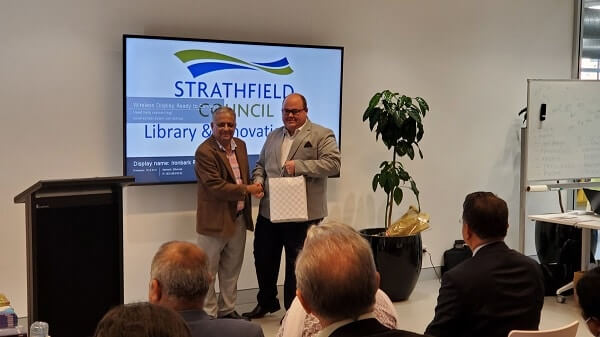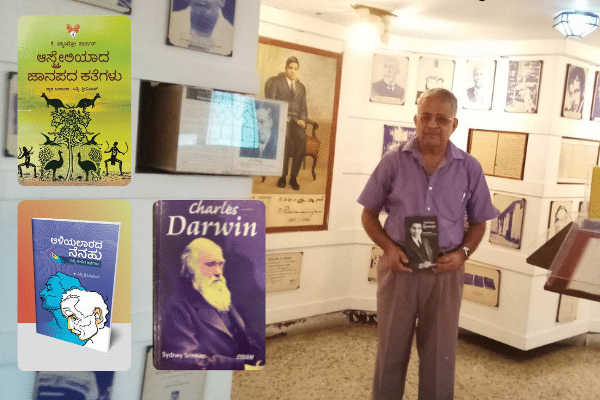In a wonderful hattrick, Sydney-based writer Dr Karkenahalli (Sydney) Srinivas launched three books this month.
These include Charles Darwin, a biography in English (Prism Book House, Bangalore), and two books in his native tongue Kannada – an anthology of short stories Aliyalarada Nenahu (also Prism Book House) and Australian folk tales Australia Janapada Kathegalu, (Nava Karnataka, Bangalore).
Dr Sydney Srinivas migrated to Australia from India more than four decades ago and has assimilated so well with Australian culture and ethos that Sydney is now an integral part of his name.
At work, he was a senior academic in the University of Sydney’s school of Aerospace and Mechanical Engineering. Outside of work, in the Indian community, he is known for his deep knowledge in the fine arts, in theatre and music and as a writer of both.
It is rather rare to find a scientist who analyses Fluid Dynamics with the same ease and fluency with which Srinivas analyses a varnam in Mohana raga at a Bharatanatyam arangetram.
He traverses the two spheres of science and fine arts with ease, establishing that the two are not mutually exclusive. He is blessed with the sharp intellect that scientific research requires and the sensitive, empathetic approach that appreciation of music, films, literature needs.

In the same vein, Srinivas places himself comfortably between two countries and two cultures and is able to observe the similarities, the contrasts, and the mutual influence between them. His observations, analysis, questioning and acceptance of the two countries are captured beautifully in his latest work of short stories in Kannada, Aliyalarada Nenahu (Indelible Memory).
It is easy to identify with many of the characters in these stories, the first-generation migrants who struggle to adjust to the change of values in their offspring, who are much more confident and vocal. The youngsters challenge the stereotypes and long-held beliefs, causing discomfort in the seniors but also opening them up to new possibilities and pushing them away from their comfort zone.
The story of a young lawyer who opts to be a single mum through assisted technology is particularly poignant. The young lady breaks free from her father’s control and asserts her independence while the traditional mother concurs and silently supports her daughter’s decision.
Some stories are nostalgic. The curiosity and feelings evoked in the protagonist when he chances upon an old acquaintance on social media is described beautifully. ViLasa (Address) is another impactful short story of an old man with dementia who is lost in a suburban train station, who the author tries to reach home.
Sydney is the canvas on which these stories are painted. The city comes alive with the description of its suburbs, landmarks and train stations, almost as if it were a character in the stories!
The second book, Australia Janapada Kathegalu will see Australian folklore available to a whole new audience, and could perhaps have not come at a better time, when the relationship between Indian and Australia is blossoming in a variety of areas, and the diaspora is seen as capable of building bridges. Readers who are familiar with the Indian Panchatantra stories can relate very easily to the Aboriginal folk tales.
There are no kings and queens and soldiers in these folktales. The woodpecker Beibei, an emu called Dainivan, Oola the lizard, Goonur the rat or his son Goonur junior, or the stone formations of mayama are generally the heroes in these folk tales; they are invested with great prowess though they are tiny. The strong bonds that the people of the First Nation had with the flora and fauna around them is woven into each of these stories.
Some of these folktales are long and detailed and some crisp and short; but both are delightful and entertaining. The naivety and the sheer simplicity of these tales makes a refreshing read in these days of atomic warfare and biological weaponry!
As a scientist, Srinivas has a particular passion to take science to the masses. For many, science can be an enigma, something distant and difficult to comprehend. Srinivas has addressed this issue by writing the biographies of great scientists like Galileo Galilei, Marie Curie, Alan Turing, Alfred Nobel, Henry Ford, Srinivasa Ramanujan, Albert Einstein, Isaac Newton and the latest addition, Charles Darwin. (Four of these biographies are in the English language, and nine in Kannada.)
Srinivas portrays his subjects as normal human beings with their strengths and weaknesses, their likes and dislikes and common human failings. The only thing that makes them stand apart is their intense passion and perseverance.
The biographies are written in a simple language and lucid style making them interesting to the scientist and the layman alike. This attempt at bringing scientific concepts and scientists within the common man’s’ grasp is indeed a laudable effort.
Srinivas’ three new books bear testimony to his linguistic skills, as well as his academic bent of mind, unpacking and demystifying thematic concepts to new audiences.
Speakers at the book launch lauded Srinivas’ prolific work – calling him an ‘ideal retiree’ – and also offered suggestions for new biographies.
READ ALSO: Visiting the birthplace of Isaac Newton




